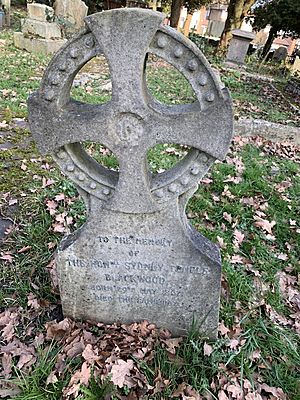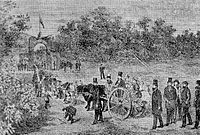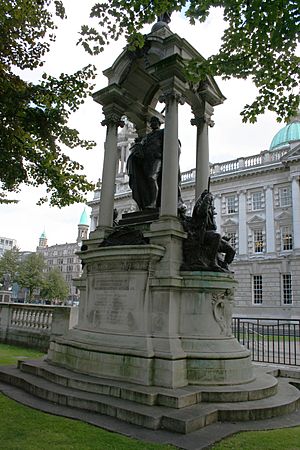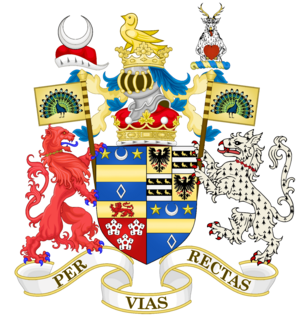Frederick Hamilton-Temple-Blackwood, 1st Marquess of Dufferin and Ava facts for kids
Quick facts for kids
The Most Honourable
The Marquess of Dufferin and Ava
|
|
|---|---|
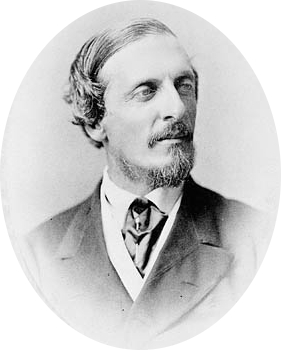
Lord Dufferin in 1873
|
|
| Viceroy and Governor-General of India | |
| In office 13 December 1884 – 10 December 1888 |
|
| Monarch | Victoria |
| Preceded by | The Marquess of Ripon |
| Succeeded by | The Marquess of Lansdowne |
| 3rd Governor General of Canada | |
| In office 25 June 1872 – 25 November 1878 |
|
| Monarch | Victoria |
| Prime Minister | Canadian: Sir John A. Macdonald Alexander Mackenzie British: William Ewart Gladstone The Earl of Beaconsfield |
| Preceded by | The Lord Lisgar |
| Succeeded by | Marquess of Lorne |
| Chancellor of the Duchy of Lancaster | |
| In office 12 December 1868 – 9 August 1872 |
|
| Monarch | Queen Victoria |
| Prime Minister | William Ewart Gladstone |
| Preceded by | Thomas Edward Taylor |
| Succeeded by | Hugh Childers |
| British Ambassador to France | |
| In office 1891–1896 |
|
| Preceded by | The Earl of Lytton |
| Succeeded by | Sir Edmund Monson |
| Personal details | |
| Born |
Frederick Temple Blackwood
21 June 1826 Florence, Stato Vecchio Grand Duchy of Tuscany, Italy |
| Died | 12 February 1902 (aged 75) Clandeboye Estate Bangor, County Down, UK |
| Nationality | British |
| Political party | Liberal |
| Spouse | Hariot Rowan-Hamilton |
| Children |
|
| Parents |
|
| Alma mater | Christ Church, Oxford |
| Signature |  |
Frederick Temple Hamilton-Temple-Blackwood, 1st Marquess of Dufferin and Ava (born June 21, 1826 – died February 12, 1902), was an important British public servant. He was a well-known person in Victorian society. When he was young, he was popular in the court of Queen Victoria. He became famous after writing a best-selling book about his travels.
He is remembered as one of the most successful public servants of his time. His long career started in 1860 as a special representative to Syria. There, his clever diplomacy helped protect British interests. He also stopped France from taking control of Lebanon.
After his success in Syria, Dufferin worked for the British government. He served as the Chancellor of the Duchy of Lancaster and as an Under-Secretary of State for War. In 1872, he became the Governor General of Canada. He helped strengthen ties between Canada and the British Empire. In 1884, he reached the highest point of his career as Viceroy of India.
He also served as an ambassador to France from 1891 to 1896. After he retired in 1896, his later years were sad. He faced personal tragedies and financial problems. His oldest son died in the Second Boer War, and another son was badly hurt. He was also the chairman of a mining company that went bankrupt. He was not aware of any wrongdoing. His biographer said he was "imaginative, sympathetic, warm-hearted, and gloriously versatile." He was a great leader in Lebanon, Canada, and India. He helped avoid a war with Russia and added Burma to the British Empire.
Contents
Early Life and Adventures
Frederick Temple Blackwood was born in 1826 in Florence, Italy. His family was part of the Anglo-Irish nobility in Ireland. His father was Price Blackwood, 4th Baron Dufferin and Claneboye. His family had Scottish roots and owned a lot of land in County Down. They were given the title of Baron Dufferin in 1800.
His mother, Helen Selina Sheridan, was the granddaughter of a famous playwright. This connected his family to important literary and political people in England.
Education and Early Travels
Dufferin went to Eton and Christ Church, Oxford. He became the president of the Oxford Union Society, a debating club. He left Oxford after two years without finishing his degree. While at Oxford, he visited Skibbereen in County Cork to see the Irish Famine firsthand. He was shocked by what he saw and raised money to help the starving people.
In 1841, he became the Baron Dufferin and Claneboye after his father died. In 1849, he was appointed a Lord-in-Waiting to Queen Victoria. This meant he served the Queen directly. In 1850, he was also given the title of Baron Claneboye.
Journey to the North Atlantic
In 1856, Dufferin sailed on his schooner called Foam. He traveled around the North Atlantic. He first landed in Iceland, where he visited Reykjavík and Geysir. He tried to visit Jan Mayen Island but couldn't because of heavy ice. From there, he sailed to northern Norway and then to Spitzbergen.
When he returned, Dufferin wrote a book about his travels called Letters From High Latitudes. The book was very popular because it was funny and exciting. It was translated into many languages. He wrote the letters to his mother, with whom he was very close.
A Skilled Diplomat and Public Servant
Even though his travel book was a big hit, Dufferin chose a career in public service. He was known for his excellent writing throughout his life. His first big job was in 1860 as a British representative in Syria. He was there to investigate a civil war where Maronite Christian people were attacked.
Diplomacy in Syria
Dufferin worked with representatives from France, Russia, Prussia, and Turkey. He was very good at achieving Britain's goals. He supported Turkish rule and stopped France from creating a client state in Lebanon. He also helped remove French troops from Syria. Dufferin also protected the Druze community. He argued that if the Christians had won the war, they would have been just as violent. The plan for governing the region, which Dufferin largely suggested, was that Lebanon should be ruled separately by a Christian Ottoman who was not from Syria. For his work, he was honored with the Knight Commander of the Order of the Bath in 1861 and the Knight of the Order of St Patrick in 1864.
Advancing in Government
Dufferin's success in Syria led to a long and successful career. In 1864, he became Under-Secretary of State for India. In 1866, he moved to Under-Secretary of War. From 1868, he was the Chancellor of the Duchy of Lancaster in Prime Minister Gladstone's government. In 1871, he was given higher titles: Earl of Dufferin and Viscount Claneboye.
Family Life
Lord Dufferin added "Hamilton" to his name in 1862, just before marrying Hariot Georgina Rowan-Hamilton. This marriage also helped end some old family disagreements. He later added "Temple" to his name in 1872. They had seven children who lived. Their two youngest children were born in Canada.
- Archibald James Leofric Temple Hamilton-Temple-Blackwood, Earl of Ava (1863–1900), was a soldier and writer. He was hurt during the Second Boer War and died a week later.
- Lady Helen Hermione Hamilton-Temple-Blackwood (1865–1941), married Ronald Munro Ferguson, who became Governor-General of Australia. They had no children.
- Terence Hamilton-Temple-Blackwood, 2nd Marquess of Dufferin and Ava (1866–1918). He married and had three daughters.
- Lady Hermione Catherine Helen Hamilton-Temple-Blackwood (1869–1960) became a nurse. She served in France during First World War. She received an award for her service.
- Lord Ian Basil Gawaine Temple Hamilton-Temple-Blackwood (1870–1917) was a lawyer. He worked in South Africa and Barbados. He was killed in action during World War I. He also drew pictures for books.
- Lady Victoria Alexandrina Hamilton-Temple-Blackwood (1873–1938), whose godmother was Queen Victoria. She married twice and had eight children.
- Frederick Hamilton-Temple-Blackwood, 3rd Marquess of Dufferin and Ava (1875–1930).
They also had a son named Sydney Temple Blackwood, who was born and died on the same day in 1867. His gravestone is in London.
Dufferin was very sad when his mother died in 1867. He built Helen's Tower on his estate as a memorial to her. A nearby bay and a railway station were also named after her.
Serving Canada as Governor General
Dufferin became the Governor General of Canada in 1872. His six years in Canada were a time of big changes. During his term, Prince Edward Island joined Canada. Important Canadian institutions were also created, like the Supreme Court of Canada and the Royal Military College of Canada.
Dufferin wanted to be a more active Governor General. He tried to meet and understand ordinary Canadians. He spoke both English and French and was known for being charming and welcoming. He believed that connecting with Canadians would strengthen their ties to Britain. He visited every Canadian province, being the first Governor General to visit Manitoba.
Involvement in Canadian Politics
Lord Dufferin took a great interest in Canadian politics. He even advised ministers to change policies he thought were wrong. He followed debates in the Parliament. As the Queen's representative, he could not enter the House of Commons. So, he set up an office there, and Lady Dufferin would attend debates and tell him what happened.
In 1873, a scandal called the Pacific scandal happened. The government was accused of financial wrongdoing. Dufferin stopped parliament and started an investigation. The investigation found the government guilty, and the Prime Minister, John A. Macdonald, lost power.
Promoting Education and Sports
In 1873, Dufferin created the Governor General's Academic Medals. These awards recognize top students in Canada. More than 50,000 of these medals have been given out. He also started sports prizes, like the Governor General's Match for shooting and the Governor General's Curling Trophy.
Improving Rideau Hall and Quebec City
Dufferin made many improvements to Rideau Hall, the Governor General's home. He added a ballroom in 1873 and a Tent Room in 1876 for events. He also built an ice skating rink for the public. These changes made Rideau Hall an important social center.
The Dufferins also loved the Citadel of Quebec in Quebec City. When city officials started tearing down the old city walls, Dufferin stopped them. He convinced them to repair and restore the damaged parts. Old Quebec later became a World Heritage Site. Dufferin's last public appearance in Canada was in Quebec City. He laid the foundation stone for Dufferin Terrace, a large walkway overlooking the St Lawrence River. This walkway was designed by him and is one of his most famous legacies in Canada. In 1876, he was made Knight Grand Cross of the Order of St Michael and St George.
Lady Dufferin was also very active in Canada. She traveled with her husband and appeared in public often. In 1877, she and Lord Dufferin each drove a spike into the new Canadian Pacific Railway line. The first engine on the railway was named Lady Dufferin. Lady Dufferin wrote letters to her mother about her time in Canada. These were later published as My Canadian Journal. She said her time in Canada was her happiest.
Many Canadian schools, streets, and buildings are named after the Dufferins. Lord Dufferin is especially remembered in Manitoba. A statue of him stands outside the provincial legislature.
Diplomatic Roles in Russia and Turkey
After leaving Canada in 1878, Dufferin returned to Britain. He continued his diplomatic career. He was ambassador to Imperial Russia from 1879 to 1881. Then he served as ambassador to the Ottoman Empire from 1881 to 1884.
Dufferin had been part of Liberal governments before. However, he disagreed with Prime Minister William Ewart Gladstone on some issues. He accepted the ambassador role in Russia from the Conservative leader, Benjamin Disraeli.
Time in Russia
His time in Russia was mostly quiet politically. His writings from this period are mainly about his social life. While in Russia, he started to hope for the top diplomatic job: the Viceroyalty of India. However, someone else got that job first.
Events in the Ottoman Empire
Dufferin's next job was in Constantinople (now Istanbul). During this time, Britain invaded and occupied Egypt. Egypt was technically part of the Ottoman Empire. Britain said they were "restoring law and order" after riots. Dufferin played a big part in these events.
He made sure the Ottoman Empire did not gain military control in Egypt. He also calmed the people of Egypt by preventing the execution of Urabi Pasha. Urabi had led resistance against foreign influence. Dufferin believed executing him would cause more trouble. Instead, he made sure Urabi was sent away to Ceylon.
In 1882, Dufferin went to Egypt as a British commissioner. He was there to help reorganize the country. He wrote a report, known as the Dufferin Report. It explained how the occupation would help Egypt. It included plans for Egyptians to gradually take more control of their country. Many reforms followed his suggestions. He was promoted to Knight Grand Cross of the Order of the Bath in 1883.
Leading India as Viceroy


His experiences in Russia and Turkey made him more aware of the British Empire's role in the world. His time in Russia also showed him the Russian threat to British rule in India. In 1884, he finally achieved his goal of becoming Viceroy of India. This meant he was also Grand Master of the Order of the Star of India and the Order of the Indian Empire.
Changes and Challenges in India
Like in Canada, he oversaw big changes in India. The previous Viceroy, Lord Ripon, was popular with Indians but not with the British in India. Dufferin needed to gain support from both groups. He was very successful at this. He helped the Indian Nationalists without upsetting the conservative British. The Indian National Congress was founded during his time in 1885. He also helped create the modern Indian Army.
He often dealt with international issues. In 1885, he handled the Panjdeh Incident in Afghanistan. Russian forces moved into Afghan territory. Britain and Russia had been in a "cold war" in Central Asia and India for decades, known as the Great Game. This incident could have started a full war. Dufferin negotiated a deal where Russia kept some land but gave up other territories. During his term, Upper Burma was also added to the British Empire in 1886.
In 1888, he published the Report on the Conditions of the Lower Classes of Population in Bengal. This report showed the difficulties faced by poor people in Bengal. Nationalists used it to argue that British rule had not helped the poorest Indians. After the report, Dufferin suggested creating councils with Indian members. This was a key demand of the Indian National Congress.
His time as Viceroy was mentioned in a poem by Rudyard Kipling called 'One Viceroy Resigns'. The poem was written from Dufferin's point of view, giving advice to his successor.
His wife, Lady Dufferin, Vicereine of India, traveled with him in India. She became famous for helping women get medical training in India. Her travel writings and photos show how women played important roles in colonial life.
Later Years and Legacy
After returning from India, Dufferin continued his ambassador career. He served as ambassador to Italy from 1888 to 1891. In 1888, he was given even higher titles: Marquess of Dufferin and Ava and Earl of Ava. As ambassador to France from 1891 to 1896, he dealt with difficult relations between Britain and France. He helped create the Anglo-French Guild, which is now the University of London Institute in Paris.
After retiring in 1896, Dufferin became President of the Royal Geographical Society. He also became Rector of the University of Edinburgh and the University of St Andrews. He received an honorary law degree from the University of Glasgow in 1901.
Dufferin often spent more money than he had. He had to sell a lot of his land to pay off his debts. After he retired, he was asked to join financial companies. In 1897, he became chairman of the London and Globe Finance Corporation. This company was involved in mining. However, the company's shares crashed in 1900, and it went bankrupt. It turned out the company's leader was a fraudster. Dufferin lost a lot of money, but he was not involved in any wrongdoing.
Soon after this, Dufferin's oldest son died in the Boer War. Dufferin returned to his home at Clandeboye in poor health. He died on February 12, 1902. Lady Dufferin died in 1936.
The Ghost Story of Lord Dufferin
Dufferin often told a story about seeing a ghost that saved his life. One night in 1849, he was staying in a house in Ireland. He heard a hearse arrive and saw a man carrying a coffin. The man looked up at Dufferin, and then disappeared. Dufferin thought it might have been a dream. But his hostess told him that if he saw the ghost again, he would die.
Years later, Dufferin was the British ambassador to France. He recognized the lift operator at a hotel in Paris as the man from his dream. He refused to get into the lift. Moments later, the lift crashed, killing everyone inside, including the mysterious man. The man had only started working at the hotel that morning.
Later investigations showed that this story was likely an urban legend. Dufferin probably made it more personal when he told it. The story has been retold in books and films, including a segment in the movie Dead of Night and an episode of The Twilight Zone.
Arms
Places Named After Lord Dufferin
Many places and things are named in honor of Lord Dufferin:
- Ship: IMMTS Dufferin
- Geographic locations:
- British Columbia: Dufferin Island
- Nova Scotia: Dufferin Street, Bridgewater
- Ontario: Dufferin County
- Ontario: Dufferin Street, Toronto
- Ontario: Dufferin Islands, Queen Victoria Park, Niagara Falls
- Ontario: Dufferin Subway Station, Toronto Transit Commission, Toronto, Ontario
- Quebec: Autoroute Dufferin-Montmorency, Quebec City
- Quebec: Terrasse Dufferin, Quebec City
- Saskatchewan: Dufferin Avenue, Imperial
- South Australia: County of Dufferin
- Spitsbergen: Kapp Dufferin
- Mandalay, Burma: Fort Dufferin
Images for kids



